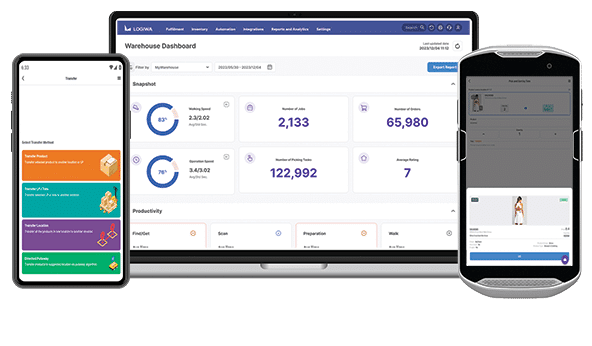For retailers, fulfillment networks and third-party logistics (3PL) providers, ongoing process ‘optimization’ is crucial to meeting rising consumer demand, surpassing competitors, and scaling fulfillment operations long-term. It is not a single step, but a perpetual process of evaluating strategies, partnerships and technology in order to oversee highly successful operations.
Warehouse operators employ various strategies to continuously improve warehouse fulfillment processes and deliver products to customers fast, accurately, and at the lowest cost possible. But with so many ways to boost warehouse efficiency and streamline fulfillment, it can be easy to overlook certain processes – some which provide the biggest impact of all.
In this blog, Logiwa covers common approaches to warehouse optimization, three of the most overlooked processes to prioritize and how a modern warehouse management system (WMS) supports each with ease.
Contents
Key Takeaways
- When it comes to warehouse optimization, adopting warehouse automation technology, smart inventory management systems and data-driven analytics are key to achieving fulfillment excellence.
- Directed putaway, or suggested putaway, is an often overlooked form of inventory management that optimizes stock allocation and plays a significant role in streamlining other warehouse processes.
- In order to ensure optimum efficiency, operations need to standardize and automate exception-handling rules, which quickly resolve unexpected issues or discrepancies that occur during fulfillment processes.
- Modern WMS solutions can directly integrate with shipping carriers and incorporate competitive automation features (i.g. Label making, rate shopping, carrier selection, product dimensioning, etc.) to optimize shipping operations.
- In the face of today’s high-volume direct-to-consumer (DTC) demand, fulfillment operations need to explore every option of warehouse optimization in order to achieve fulfillment excellence.
Essential Warehouse Optimization Strategies
Before discussing overlooked forms of warehouse optimization, it is important to acknowledge that all forms of warehouse optimization matter. For those just starting out on their optimization journeys, there are three standard approaches to adopt. These include: warehouse automation technology, inventory management systems and data-driven analytics.
Warehouse Automation
Process automation, which can include physical and facilitatory automation, is a pivotal approach for optimizing warehouse operations and fulfillment results. It involves adopting technology that can perform tasks that are usually carried out manually, as well as setting up automation rules, automated workflows and AI-powered algorithms within a WMS.
Combining physical automated machinery like conveyor systems, automated guided vehicles (AGVs) and robotic picking systems with system automation features like smart job creation and picking algorithms significantly reduces operational costs, enhances productivity, and minimizes the likelihood of errors, which creates a more efficient fulfillment process overall.
Inventory Management Technology
Another crucial approach to warehouse optimization is leveraging advanced inventory management technology. The next-generation of WMS solutions provides real-time visibility into inventory levels, locations, and movements throughout single and multi-warehouse fulfillment networks. With accurate and timely inventory information, it becomes possible to optimize replenishment strategies, allocate storage space more effectively, and prevent overstocking or stockouts.
Inventory management technology can also be integrated with ecommerce platforms and order management features within a WMS. Operations that use barcoding, RFID (Radio Frequency Identification), or advanced technologies like IoT (Internet of Things) sensors can track products throughout warehouses and feed live data to a WMS to streamline fulfillment processes. By having a comprehensive understanding of inventory, warehouse operations can minimize carrying costs, allocate resources efficiently based on consumer demand and optimize fulfillment.
Data Analytics
Data-driven analytics play a pivotal role in optimizing warehouse operations. By aggregating and analyzing vast amounts of data throughout a fulfillment network, businesses can uncover and correct inefficiencies. Through holistic data analysis, BI and analytics tools help identify patterns in order volume, product popularity and seasonal trends, allowing operators to forecast demand accurately and adjust staffing and inventory levels to optimum levels.
Moreover, analyzing order processing times, picking routes, and the results of established packing strategies can highlight bottlenecks in workflow, leading to targeted process improvements. These insights can also aid in evaluating the performance of specific warehouses, carriers and other partners to create a more integrated fulfillment network. Ultimately, data-driven analytics empower operations to make informed and proactive decisions that enhance efficiency, reduce costs, and meet consumer demand more effectively.

3 Overlooked Warehouse Optimization Strategies
With those foundational approaches established, let’s dig into three powerful, and often overlooked, avenues for maximizing warehouse performance and improving fulfillment results.
Directed Putaway
Putaway might not seem like the most significant process for warehouse optimization, but it actually plays the largest role in streamlining operations. It affects the extent to which other warehouse processes can be optimized, especially when it comes to picking, packing or reverse logistics, as well as the cost-effectiveness of facility and resource management.
Directed putaway, or suggested putaway, is a form of smart inventory management that optimizes stock allocation. It simplifies inbound operations and streamlines inventory transfers using configurable software rules and AI. It identifies the best locations for stock based on item popularity, projected demand, client needs, product expirations, weight capacity, and other custom characteristics in order to optimize speed and accuracy.
Some examples of how directed putaway contributes to warehouse optimization, include:
- Storing items with a high turnover rate near sorting and packing stations;
- Minimizing the distances pickers have to walk (and the number of stops that have to be made) to fulfill orders;
- Prioritizing the closest, easy-to-reach locations for picking and packing tasks;
- Transferring inventory to make room for new items as stock changes and grows;
- Placing soon-to-expire items so they will be picked before those with longer remaining shelf lives; and
- Creating valuable warehouse space so operations can do more with their existing facilities.
For more insights, read Logiwa’s blog, “Directed Putaway: A Smart Approach to Product Storage in the Warehouse.”
Exceptions-Handling
Another warehouse optimization process that is often overlooked has to do with formalizing a process for exceptions, whether that be for manual or automated operations. Standardized processes are needed when an unexpected issue or discrepancy occurs during picking and packing processes, otherwise resolving the problems can become a major time sink and disruption.
For example, when a picker arrives at a designated item location, and the product is missing, the picker is forced to report the problem to a manager, re-establish a new location for retrieving the item and start the picking task over again. This is inefficient on two fronts: it requires an advisor to investigate and resolve an inventory issue, and it leaves the picker to duplicate picking tasks due to the first location not providing the order item.
As another example, when an employee finds that the items they are preparing to ship does not match the order items on screen (or perhaps the packing list being used to verify the order), they must take time to cancel and re-submit the order. If done manually, the employee may need to void the order, restock items, verify inventory systems have been updated, and ensure the order is assembled again. Even with the help of automation, these occurrences are costly and time consuming.
In order to ensure optimum efficiency, operations need exception-handling rules. WMS solutions can be configured to register “inventory discrepancies” and automatically prompt next-steps for resolving the issue. Exception-handling expedites the resolution of problems so processes like picking or packing do not have to stop. That way, when discrepancies are flagged, the WMS initiates the necessary processes without interrupting day-to-day operations.
WMS Shipping Features
Shipping is often considered one of the more challenging fulfillment processes to optimize within the warehouse. The intricate elements involved, such as choosing a shipping carrier, generating lablems, and selecting appropriate shipping materials, often require manual participation and decision-making. But nowadays, WMS can directly integrate with shipping carriers and incorporate competitive automation features to improve efficiency.
Some of the key WMS features that help optimize shipping operations, include:
- Automated label making;
- Print and apply capabilities;
- Rate shopping between multiple carriers;
- Options for choosing the cheapest carriers by delivery date; and
- Shipping box selection based on product dimensioning.
Taking the time to combine multiple WMS shipping features and implement specific automation rules expedites order processing, improves fulfillment accuracy, and bolsters customer satisfaction without adding extra work. Shipping offers a final opportunity to optimize warehouse operations as a whole, so it is important that operators explore every enhancement.
Learn more how Logiwa addresses these three optimization strategies with our cloud WMS and fulfillment solution by reaching out for a free consultation or watching our QuickTake webinar, “Ask Our Experts: Get Answers to Your WMS Questions.”
Logiwa’s Warehouse Optimization Software
In the face of today’s high-volume direct-to-consumer (DTC) demand, fulfillment operations need to explore every option of warehouse optimization in order to achieve fulfillment excellence. This requires a combination of next-generation WMS features with strategic approaches to every stage of the fulfillment process: from receiving and putaway to picking, packing and shipping.
Logiwa WMS was built to ensure seamless, high-efficiency fulfillment. As a cloud native fulfillment solution, Logiwa’s solution offers high levels of configurability and regular enhancements to ensure users are equipped with the latest industry-leading features. For more guidance on optimizing warehouse operations, visit the Logiwa Resource page.
Ready to see Logiwa WMS in action, request a free demo today.
FAQs about Warehouse Optimization
How can you improve warehouse performance?
Warehouse optimization can be achieved through a variety of methods. Some basic forms include adopting a high-efficiency warehouse management system (WMS), replacing manual warehouse processes with physical and facilitatory automation, utilizing a smart inventory management system, and embracing BI and analytics tools to root out bottlenecks and inefficiencies.
What are some overlooked areas of warehouse optimization?
Some of the most overlooked areas of warehouse optimization include: receiving and putaway, exceptions, and shipping since each presents its own unique challenges. Directed putaway offers a way to optimize inventory and facility management, as well as streamline processes like picking and packing, by ensuring that all warehouse items are in the best possible location for operational success. Exceptions-handling offers an avenue for standardizing and automating processes related to unexpected issues that arise throughout various stages of fulfillment. Leading shipping features, such as rate shopping and automated label printing, can have impacts on cost-savings and efficiency in the final stages of warehouse operations.
How do you evaluate warehouse optimization software?
Leveraging BI and analytics tools, benchmarking using your operational key performance indicators (KPIs), and regularly monitoring data related to fulfillment success rate, throughput, returns and other fulfillment-related metrics can all help identify if your WMS is achieving its full potential. If you suspect there are more ways to automate your processes or enhance your existing features, it is important to reach out to your customer success manager directly.
Modern cloud fulfillment software built specifically for B2C and DTC fulfillment
Warehouse Management
Modern digital WMS powers a modern fulfillment experience






